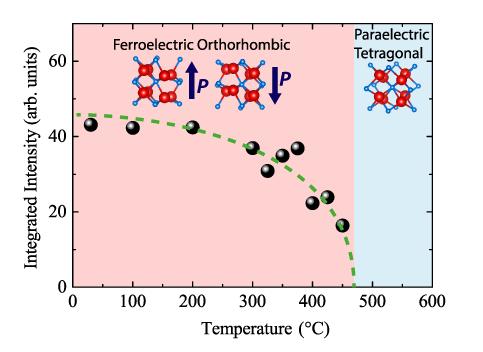
Ultra-Thin Ferroelectric Material Advances Next-Gen Electronics

Scientists at Tokyo Institute of Technology have demonstrated the potential of a new, thin-film ferroelectric material that could improve the performance of next-generation sensors and semi-conductors.
Credit: Tokyo Institute of Technology
Now, Hiroshi Funakubo and co-workers at the Tokyo Institute of Technology, in collaboration with researchers across Japan, have conducted experiments to determine the ferroelectric properties of an inorganic compound called hafnium oxide (HfO2) for the first time. Crucially, the crystal structure of HfO2 allows it to be deposited in ultra-thin films, meaning it may prove invaluable for next-generation technologies.
Ferroelectric properties stem from the shape and structure of the crystal used. The team knew that an 'orthorhombic' crystal of HfO2 would likely exhibit ferroelectricity. Funakubo's team wanted to pinpoint the material's spontaneous polarization and the Curie temperature (the point above which a material stops being ferroelectric due crystal re-structuring). To do this, they needed to grow a carefully-ordered crystal on a substrate, a process known as epitaxy, which would give them well-defined data on an atomic scale.
The researchers found that one particular epitaxial film, labelled YHO-7, exhibited ferroelectricity with a spontaneous polarization of 45μC/cm and a Curie temperature of 450 °C (see image). The experimental results confirm earlier predictions using first principle calculations.
From a scientific and industrial point of view, a Curie temperature of 450 °C is of great interest, because it means the material could fulfil functions for future technologies. In contrast to many existing ferroelectric materials, the new thin-film exhibits compatibility with Si-based CMOS and is robust in miniature forms.
Background
Ferroelectric materials
Ferroelectric materials differ from other materials because their polarization can be reversed by an external electric field being applied in the opposite direction to the existing polarization. This property stems from the materials' specific crystal structure. Ferroelectric materials are highly valuable for next-generation electronics. While a number of ferroelectric materials are known to science and are already used in different applications, their crystal structure does not allow them to be scaled down to a small enough, ultra-thin film for use in miniaturized devices.
The material used by Funakubo and co-workers, hafnium oxide (HfO2), had previously been predicted to exhibit ferroelectric properties through first principle calculations. However, no research team had confirmed and examined these predictions through experiments. Funakubo's team decided to measure the properties of the material when it was deposited in thin-film crystal form onto a substrate. The precise nature of the crystal structure enabled the researchers to pinpoint the material's properties in full for the first time.
Their discovery of a particular epitaxial thin-film crystal of HfO2 that exhibits ferroelectricity below 450 °C will be of great significance in the field.
Implications of the current study
Funakubo's team are hopeful that their new thin film ferroelectric material will have applications in novel random-access memory and transistors, along with quantum computing. Their material is also the first ferroelectric material compatible with silicon-based semiconductors (Si-based CMOS).
Media Contact
Emiko Kawaguchi
media@jim.titech.ac.jp
81-357-342-975















